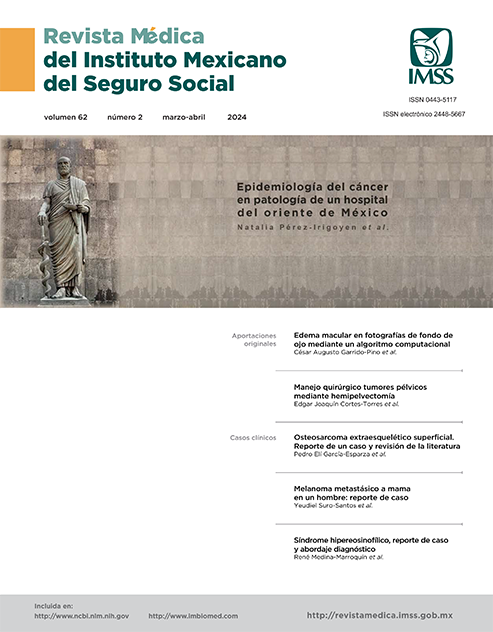Petersen's hernia after laparoscopic gastric bypass
Main Article Content
Keywords
Gastric Bypass, Hernia, Laparoscopy
Abstract
Background: RYDG is the second most prevalent bariatric operation worldwide in terms of surgical treatment for the management of obesity and its comorbidities; however, one of its complications is the development of Petersen's space hernia. Currently there is no specific cause for their development since, based on studies published worldwide, they have an unpredictable behavior in each individual.
Objective: To establish the prevalence of Petersen's hernia and risk factors for its development.
Material and methods: Retrospective cohort study that included patients who underwent laparoscopic gastric bypass from January 2015 to December 2020. All procedures were performed by a single surgeon using antecolic and retrogastric configuration. Study variables: weight, BMI, mesenteric gap closure, suture material used, post-surgical complications.
Results: 100 patients were included, 64 women and 36 men, age 40.33 ± 2.08 years. The prevalence of Petersen's space hernia was 3% with a mean presentation time of 18 ± 7.54 months. The variables related to its development in the 3 cases were closure of the mesenteric gap, height, body mass index (BMI) and weight after the surgical procedure.
All patients underwent reoperation, reducing the content and closing the mesenteric gap with non-absorbable suture material.
Conclusion: The development of the hernia not only depends on the closure of the mesenteric gap, but also on the reduction of weight and loss of volume of the mesentery with the reopening of the space.
References
Sarkar R, Sedman PC. Patient Selection in Bariatric Surgery. In: Obesity, Bariatric and Metabolic Surgery. Cham: Springer International Publishing; 2016 p. 77-83. Available from: https://link.springer.com/chapter/10.1007/978-3-319-04343-2_8
Kermansaravi M, Kazazi M, Pazouki A. Petersen’s Space Internal Hernia after Laparoscopic One Anastomosis (Mini) Gastric Bypass. J. Surg. Case Rep; 2018;1;2018:9576120. doi: 10.1155/2018/9576120.
Blockhuys M, Gypen B, Heyman S, et al. Internal Hernia After Laparoscopic Gastric Bypass: Effect of Closure of the Petersen Defect - Single-Center Study. Obes Surg. 2019 ;29(1):70-75. doi: 10.1007/s11695-018-3472-9.
Collard MK, Torcivia A, Genser L. Laparoscopic management of internal hernia after Roux-en-Y-gastric bypass. Laparoscopic management of internal hernia after Roux-en-Y-gastric bypass. J. Visc Surg. 2020;157(5):423-427. doi: 10.1016doi: 10.1016/j.jviscsurg.2020.08.013.
Cadena-Obando D, Ramírez-Rentería C, Ferreira-Hermosillo A, et al. Are there really any predictive factors for a successful weight loss after bariatric surgery. BMC Endocr. Disord. 2020;5:20(1). doi: 10.1186/s12902-020-0499-4.
López-Morales P, González-Valverde FM, Albarracín Marín-Blazquez A. Petersen’s space hernia after gastric bypass.Cir Cir, 2020;88(6):772-5. 10.24875/CIRU.20000905
Magouliotis DE, Tzovaras G, Tasiopoulou VS, et al. Closure of Mesenteric Defects in Laparoscopic Gastric Bypass: a Meta-Analysis. Obes. Surg. 2020;30(5):1935-1943. doi: 10.1007/s11695-020-04418-2.
Ahn H, Lee S-H, Jeon TY, et al. Clinical features of internal hernia after gastrectomy for gastric cancer. Minim. Invasive Surg. 2021;24(1):18-25. doi: 10.7602/jmis.2021.24.1.18.
Min J-S, Park J, Bae K, et al. Prediction of the possibility of laparoscopic reduction of Petersen’s hernia after gastrectomy: multicenter observational cohort study. Wideochir Inne Tech Maloinwazyjne. 2021;16(3):543-551. doi: 10.5114/wiitm.2021.103964.
Mahawar KK, Parmar C, Graham Y. One anastomosis gastric bypass: key technical features, and prevention and management of procedure-specific complications. Minerva Chir. 2019;74(2):126-36.
Blockhuys M, Gypen B, Heyman S, et al. Internal Hernia After Laparoscopic Gastric Bypass: Effect of Closure of the Petersen Defect - Single-Center Study. 2019;29(1):70-75. doi: 10.1007/s11695-018-3472-9
Al-Mansour MR, Mundy R, Canoy JM, et al. Internal Hernia After Laparoscopic Antecolic Roux-en-Y Gastric Bypass. Obes Surg. 2015;25(11):2106-11. doi: 10.1007/s11695-015-1672-0
Petrucciani N, Martini F, Kassir R, et al. Internal Hernia After One Anastomosis Gastric Bypass (OAGB): Lessons Learned from a Retrospective Series of 3368 Consecutive Patients Undergoing OAGB with a Biliopancreatic Limb of 150 cm. Obes Surg 2021;31(6):2537-2544. doi: 10.1007/s11695-021-05269-1.
Muir D, Choi B, Clements C, et al. Mesenteric Defect Closure and the Rate of Internal Hernia in Laparoscopic Roux-en-Y Gastric Bypass: A Systematic Review and Meta-analysis. Obes Surg. 2023;10. doi: 10.1007/s11695-023-06597-0.
Brammerloo YGA, Vannijvel M, Devriendt S, et al. Internal Hernia After Laparoscopic Gastric Bypass Without Preventive Closure of Mesenteric Defects: a Single Institution's Experience. J Gastrointest Surg. 2021;25(3):623-634. doi: 10.1007/s11605-020-04761
Pokala B, Giannopoulos S, Stefanidis D. Prevention and management of internal hernias after bariatric surgery: an expert review. Mini-invasive Surg. 2022;6:23. doi: 10.20517/2574-1225.2021.136
Schneider R, Schulenburg M, Kraljević M, et al. Does the non-absorbable suture closure of the jejunal mesenteric defect reduce the incidence and severity of internal hernias after laparoscopic Roux-en-Y gastric bypass?. Langenbeck's. Arch. Surg. 2021;406(6):1831-8. doi: 10.1007/s00423-021-02180-2.
Yao L, Kitaghenda FK, Hong J, et al. Is the Closure of Petersen’s Space Unnecessary in All Single Anastomosis Bariatric Procedures? Obes Surg. 2022;32(11):3782-4. doi: 10.1007/s11695-022-06274-8
Ross SW, Iannitti DA. Mesh. In: Shackelford’s Surgery of the Alimentary Tract, 2 Volume Set. Elsevier; 2019 [cited 2022 Dec 21]. p. 621-32. Disponible en: https://linkinghub.elsevier.com/retrieve/pii/B9780323402323000558
Seeras K, Philip K, Baldwin D, et al. Laparoscopic Gastric Bypass. Treasure Island (FL): StatPearls Publishing; 2022. Disponible en: https://pubmed.ncbi.nlm.nih.gov/30085510/


